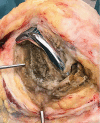Massive osteolysis due to galvanic corrosion after total knee arthroplasty: a rare cause for early revision?
- PMID: 32047588
- PMCID: PMC7006524
- DOI: 10.1093/jscr/rjaa002
Massive osteolysis due to galvanic corrosion after total knee arthroplasty: a rare cause for early revision?
Abstract
A 66-year-old male underwent a total knee arthroplasty for osteoarthritis after previous anterior cruciate ligament (ACL) reconstruction. Seven years postoperatively, a symptomatic large lytic lesion was present surrounding the tibial stem. A titanium interference screw, which was used prior to fixate the Anterior Cruciate Ligament (ACL) graft, was in direct contact with the tibial component. Galvanic corrosion may have attributed to the development of the lytic lesion. It is advised to remove any metal hardware in the vicinity of joint prosthesis in order to prevent a possible galvanic corrosive reaction.
Published by Oxford University Press and JSCR Publishing Ltd. All rights reserved. © The Author(s) 2020.
Figures





Similar articles
-
[BTB allograft for revision surgery of the anterior cruciate ligament - part 2].Acta Chir Orthop Traumatol Cech. 2005;72(5):297-303. Acta Chir Orthop Traumatol Cech. 2005. PMID: 16316605 Czech.
-
Surgical Predictors of Clinical Outcomes After Revision Anterior Cruciate Ligament Reconstruction.Am J Sports Med. 2017 Sep;45(11):2586-2594. doi: 10.1177/0363546517712952. Epub 2017 Jul 11. Am J Sports Med. 2017. PMID: 28696164 Free PMC article.
-
Combined unicompartmental knee arthroplasty and anterior cruciate ligament reconstruction in knees with osteoarthritis and deficient anterior cruciate ligament.BMC Musculoskelet Disord. 2016 Aug 5;17:327. doi: 10.1186/s12891-016-1186-5. BMC Musculoskelet Disord. 2016. PMID: 27496245 Free PMC article. Clinical Trial.
-
High Tibial Osteotomy and Anterior Cruciate Ligament Reconstruction/Revision.Clin Sports Med. 2019 Jul;38(3):417-433. doi: 10.1016/j.csm.2019.02.008. Clin Sports Med. 2019. PMID: 31079772 Review.
-
Intraarticular migration of a broken biodegradable interference screw after anterior cruciate ligament reconstruction.Knee Surg Sports Traumatol Arthrosc. 2006 Sep;14(9):865-8. doi: 10.1007/s00167-006-0049-2. Epub 2006 Feb 15. Knee Surg Sports Traumatol Arthrosc. 2006. PMID: 16479410 Review.
Cited by
-
An Interesting Case of Osteolysis With Accompanying Metallosis in a Primary Total Knee Arthroplasty.Arthroplast Today. 2021 Aug 26;11:81-87. doi: 10.1016/j.artd.2021.07.002. eCollection 2021 Oct. Arthroplast Today. 2021. PMID: 34485655 Free PMC article.
-
Large Soft-tissue Mass Formation After Revision Total Knee Arthroplasty: An Unusual Case of Adverse Reaction to Metal Debris and Review of the Literature.Arthroplast Today. 2021 Jun 17;9:122-128. doi: 10.1016/j.artd.2021.05.001. eCollection 2021 Jun. Arthroplast Today. 2021. PMID: 34189217 Free PMC article.
-
Early Failure of Primary Total Knee Arthroplasty Due to Massive Osteolysis Caused by Bio-Absorbable Interference Screws.Cureus. 2023 Apr 26;15(4):e38143. doi: 10.7759/cureus.38143. eCollection 2023 Apr. Cureus. 2023. PMID: 37252598 Free PMC article.
References
-
- Hol PJ, Molster A, Gjerdet NR. Should the galvanic combination of titanium and stainless steel surgical implants be avoided? Injury 2008;39:161–9. - PubMed
-
- Benevenia J, Lee FY, Buechel F, Parsons JR. Pathologic supracondylar fracture due to osteolytic pseudotumor of knee following cementless total knee replacement. J Biomed Mater Res 1998;43:473–7. - PubMed
-
- Kinney MC, Kamath AF. Osteolytic pseudotumor after cemented total knee arthroplasty. Am J Orthop (Belle Mead NJ) 2013;42:512–4. - PubMed
Publication types
LinkOut - more resources
Full Text Sources

